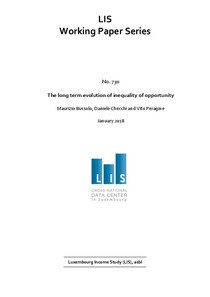The long term evolution of inequality of opportunity
"This paper uses a parametric approach to measure inequality of opportunities. It builds a simple theoretical model offering predictions on the changes of inequality of opportunity. It is expected to decline with the decline in intergenerational persistence in education, in the labour market re...
| Main Authors: | , , |
|---|---|
| Institution: | ETUI-European Trade Union Institute |
| Format: | TEXT |
| Language: | English |
| Published: |
Luxembourg
2018
LIS |
| Subjects: | |
| Online Access: | https://www.labourline.org/KENTIKA-19399578124911177509-The-long-term-evolution-of-ine.htm |
| Summary: | "This paper uses a parametric approach to measure inequality of opportunities. It builds a simple theoretical model offering predictions on the changes of inequality of opportunity. It is expected to decline with the decline in intergenerational persistence in education, in the labour market return to education and in the networking activity associated to parental background; these predictions are then taken to the data. The empirical analysis studies the evolving distribution in personal disposable incomes in five European countries (Italy, Germany, France, Great Britain and Switzerland) over a long time span. Thanks to extended samples, time trends show that the role of circumstances (parental background, gender age and place of birth) in shaping income distribution has declined over the last two decades in all countries considered. Depending on the inequality index, the inequality of opportunity (IOp) account between one third (MLD) and half (standard deviation of logs) of total inequality in personal disposable incomes. Inequality trends are then decomposed into age profiles and birth cohort changes. Inequality of opportunity exhibits an inverted U-shaped pattern over the life cycle. Moreover, the most recent age cohorts have experienced a lower IOp, thus appearing as the main beneficiaries of the overall decline in inequality. When interpreting thee observed dynamics, two parameters (intergenerational persistence in educational attainment and return of education) exhibit a declining trend, whereas the third one (networking activity of parents) is rising in most countries. The combined effect of the three movements yields a declining trend whenever the former twos dominate the latter." |
|---|---|
| Physical Description: | 25 p. Digital |

